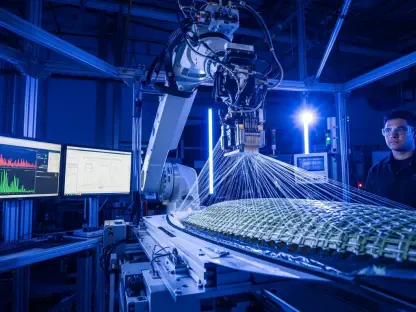In the rapidly evolving landscape of manufacturing, the convergence of IT and OT has brought about transformative changes. Kwame Zaire, a manufacturing expert with a profound understanding of predictive maintenance, quality, and safety, delves into the complex interplay between AI adoption and cybersecurity challenges within this sector. His insights shed light on the delicate balance manufacturers must maintain to harness AI’s full potential while navigating the cybersecurity paradox it presents.
What are some of the biggest cybersecurity concerns manufacturers face with the adoption of AI?
The widespread adoption of AI in manufacturing has been a game changer, offering immense benefits like enhanced efficiency and predictive analytics. However, these advancements come with significant cybersecurity concerns. As AI systems become intertwined with manufacturing operations, they create new vulnerabilities. One key concern is that AI can inadvertently expose critical OT systems to cyber threats, due to their increased connectivity and data sharing. Malicious actors can exploit these vulnerabilities to perform reconnaissance, access sensitive data, and disrupt operations.
How has IT/OT convergence influenced cybersecurity risks in manufacturing?
Historically, OT systems were somewhat insulated from the internet, providing a level of security through their proprietary nature and air-gapped networks. But the drive for digital transformation, fueled by AI, has blurred these boundaries. IT/OT convergence, with its increased connectivity, has broadened the attack surface, making OT systems susceptible to the same vulnerabilities as IT. This convergence means that breaches can now traverse from the IT environment into OT systems, impacting the ‘crown jewels’ of manufacturing operations.
Can you explain the concept of the AI cybersecurity paradox in the manufacturing sector?
The AI cybersecurity paradox in manufacturing refers to the dual nature of AI as both a solution and a threat. On one hand, AI technologies offer manufacturers powerful tools for operational efficiency and predictive capabilities. On the other hand, these same technologies can be weaponized by cyber adversaries. AI facilitates advanced reconnaissance and automated vulnerability detection, allowing attackers to accelerate their efforts with precision. Thus, while AI can protect, it also introduces new risks that must be carefully managed.
Why is the OT environment considered to contain the “crown jewels” of a manufacturing business?
OT environments in manufacturing are where critical processes occur; they’re responsible for managing and controlling machinery, logistics, and production elements. In essence, OT systems hold the operational data and control mechanisms that are crucial to the business’s success. Any compromise in these systems can lead to catastrophic impacts, such as production delays, quality issues, or safety hazards, which is why they are often viewed as the “crown jewels”.
How have adversaries leveraged AI for cyberattacks in recent years?
Adversaries have become notably adept at using AI to enhance the effectiveness and scope of their attacks. AI automates processes that were traditionally manual, such as complex network scanning and protocol fuzzing. By using AI-powered tools, attackers can perform faster and more accurate reconnaissance, mapping out network topologies and pinpointing vulnerable spots within OT environments. These capabilities enable more sophisticated and hard-to-detect attacks, escalating the cybersecurity threat level.
What role does the dark web play in providing tools for cybersecurity threats in manufacturing?
The dark web acts as a marketplace for cybercriminals, offering access to tools and services that facilitate cybersecurity threats. With minimal technical know-how required, anyone with the financial means can purchase AI-driven attack tools, consulting, and exploit kits, lowering the entry barrier for potential attackers. It provides a platform for collaboration and exchange, enabling adversaries to harness advanced technologies and methodologies for executing their attacks on manufacturing systems.
What is Network Detection and Response (NDR), and how does it help manufacturing security teams?
NDR is a cybersecurity strategy that focuses on analyzing network traffic to detect and respond to threats. For manufacturing security teams, NDR offers real-time visibility into network behavior, identifying anomalies that could signify potential threats. By leveraging AI and machine learning, NDR can flag unusual patterns that might otherwise bypass traditional security measures, enabling teams to rapidly address potential breaches before they escalate.
What are some examples of indicators of compromise (IOCs) in an OT environment?
Indicators of compromise in an OT environment can manifest as unusual network traffic, unauthorized protocol usage, or unexpected connections from OT devices. They might include anomalies like logins from unexpected locations or the sudden appearance of new user accounts. Changes in control logic or erratic equipment behavior can also signal potential threats. Identifying these IOCs is crucial for maintaining the integrity and security of manufacturing operations.
How do machine learning models assist in detecting cybersecurity threats in manufacturing?
Machine learning models are integral to evolving cybersecurity practices, as they process vast amounts of network data to identify deviations from established norms. By continuously analyzing network traffic and understanding typical behavior patterns, machine learning models can detect anomalies indicative of potential threats, such as zero-day attacks or insider threats. These models enhance the ability to foresee and mitigate risks in a proactive manner.
What types of anomalous patterns can NDR solutions identify in OT systems?
NDR solutions are particularly adept at detecting unexpected patterns or behaviors within OT systems. Examples include unauthorized attempts to connect externally, strange traffic volumes, or atypical protocol usage. They can also identify changes in equipment operation or new user accounts—anything that deviates from the established baseline of normal activity. These patterns help security teams to pinpoint and address threats before they can impact operations.
How does NDR leverage AI to protect against both known and unknown cyber threats?
NDR utilizes AI and machine learning to continuously analyze network traffic, establishing models of typical activities and flagging deviations. This allows NDR systems to detect not only known threats but also emerging, unknown threats by identifying patterns they haven’t seen before. By understanding behavioral analytics and anomaly detection, NDR systems can safeguard against sophisticated attacks that do not rely on traditional signatures.
What is the importance of behavioral analytics in NDR solutions for manufacturers?
Behavioral analytics plays a critical role in NDR solutions, as it focuses on understanding and interpreting the normal activity within networks. By establishing a baseline of behavior, manufacturers can more effectively detect anomalies indicative of threats. This approach minimizes false positives, ensuring security teams can concentrate resources on genuine threats, enhancing efficiency and protective measures within manufacturing environments.
How do sensors and packet capture work in an NDR system?
In an NDR system, sensors are deployed strategically across the network to collect data, including network flow information and deep packet inspection (DPI). These sensors capture metadata and actual packets, providing insights into network interactions and enabling the detection of suspicious behavior. Packet capture is critical for dissecting and understanding the network traffic, providing the raw data required for further analysis by AI and machine learning models.
Could you elaborate on how threat intelligence integration enhances NDR system effectiveness?
Integrating threat intelligence into NDR systems enriches security alerts with contextual information, making them more actionable. Threat intelligence provides additional data points, aligning entries with known threats and trends. This integration enables deeper insights and prioritizes responses to genuine threats, enhancing the system’s accuracy and reducing the workload on security teams by minimizing false alarms.
What automated actions can NDR solutions trigger when suspicious behavior is detected?
When anomalies are identified, NDR solutions can execute automated actions to mitigate potential threats. These can include isolating compromised devices, blocking malicious traffic, or escalating incidents for further investigation by security analysts. Automation allows rapid response, minimizing the time between detection and action, reducing the risk of widespread damage to manufacturing operations.
In what ways can NDR solutions detect threats that traditional security measures might miss?
NDR solutions go beyond traditional security measures by continuously monitoring network traffic in real-time. Unlike static endpoint protections, NDR’s machine learning-powered analysis detects subtle anomalies and patterns that might evade signature-based detection systems like firewalls. Its ability to identify lateral movement and insider threats enhances security posture, capturing threats that could otherwise slip through the cracks.
How does NDR help in identifying lateral movement and insider threats in a manufacturing environment?
NDR solutions are designed to identify patterns associated with lateral movement, a common tactic in advanced persistent threats and insider attacks. By tracking unusual network traffic flows and anomalous behavior across different network segments, NDR can effectively pinpoint the signs of an attacker trying to move through the network. This capability is essential for detecting insider threats and preventing the spread of malicious activity.
Why is proactive security crucial for manufacturing organizations in the AI era?
Proactive security is essential as it allows manufacturers to anticipate and neutralize threats before they manifest. In the AI era, where technology enables both operational enhancement and sophisticated cyberattacks, staying ahead is critical to protecting the integrity of manufacturing operations. A proactive approach ensures resilience against evolving threats, maintaining productivity and safety in an increasingly complex digital landscape.
What steps can manufacturers take to ensure their security measures remain up-to-date against evolving threats?
Manufacturers should prioritize continuous updating and reviewing of security protocols, embracing emerging technologies like AI-driven NDR. They should invest in training for their security teams to remain knowledgeable about new threat vectors and defenses. Collaborating with cybersecurity experts and adopting a layered security approach can significantly enhance their defense against evolving cyber threats.
How can manufacturing organizations maintain a balance between AI integration benefits and the associated cybersecurity risks?
Manufacturers can achieve this balance by diligently managing their AI-driven initiatives with a focus on cybersecurity. They should implement robust security architectures and protocols, ensuring that AI adoption does not inadvertently compromise sensitive systems. Regular risk assessments and strategic integrations of security measures can maximize AI benefits, while effectively mitigating associated risks.









